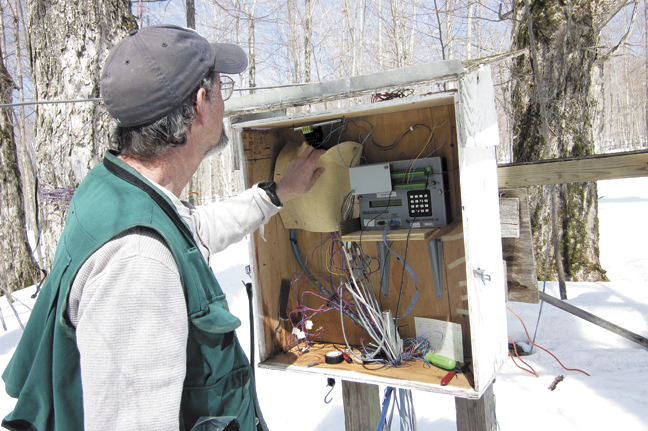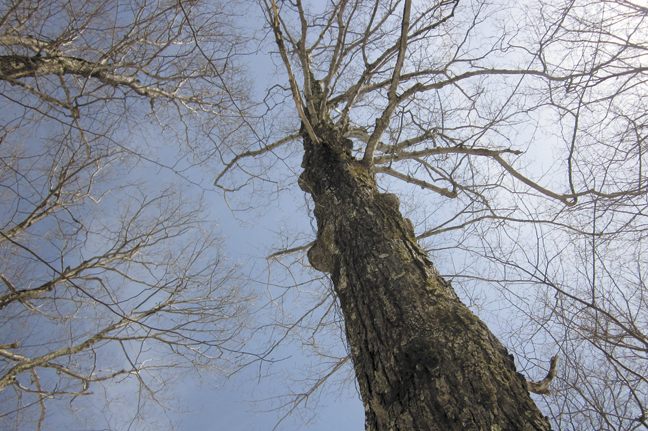UVM Proctor Page
#58, Top Performer
By DOUG WHYNOTT |
Emerson College professor Douglass Whynott has been working on a book about the maple industry for two years. He has traveled extensively throughout the maple belt collecting stories. This is an excerpt. His book was published by DeCapa Press in 2014.
The date was April 3, 2011, during the “old-fashioned winter” that had brought the best maple syrup crop in decades. I was at the sugarhouse owned by David Marvin of Butternut Mountain Farms.
I have been on several walks with David in his sugarbush, after I had found out how much he enjoyed walking in his woods and keeping track of his trees. On this morning we had walked up the snow-covered road about a half mile up to a point he calls the stone booster, where several mainlines converge into a tank, air is separated, and the sap flows through a single mainline down the hill into his sugarhouse. Six mainlines flow into the second story of David’s sugarhouse, and the sap flows into a “releaser,” before it dumps into storage tanks on the first floor.
The releaser was a new item in David’s sugarhouse, and for a while we sat watching it. If you haven’t seen a releaser, it’s an impressively powerful mechanism. It’s basically like a tank on a toilet, in that liquid flows in, and then flows out via gravity after a float is triggered. But a releaser also serves the purpose of separating sap from the vacuum system, and when it does this it makes an explosive sound. It sounds like a tremendous gasp for air, something like the air brakes on a semi, though it most reminded me of a whale’s tail smacking water. As David and I sat in lawn chairs watching the release, I flinched each time.
In the morning, when the trees were still mostly frozen, and before we took our walk to the Stone Booster, David timed the releases. They were coming every 50 seconds then, and dumping five gallons—dumping about 360 gallons an hour.
But when we returned two hours later, when the sun had come out and beat upon the tree trunks, the flow had taken off, and the releaser was now dumping every 15 seconds, four times a minute, or 1200 gallons an hour. That was about a tenth of a gallon, or 12 ounces per hour, for the 12,000 taps in David Marvin’s woods.
“Shocked into a flow,” David said. Earlier on that walk David and I had talked about the sap flow. Like anyone, I was interested in its mysteries. David had told me the equation that his father, James Marvin, had devised, that went, “The extent of the shock is equivalent to the rate of the flow.” I had asked him to repeat it. This was a beautiful idea, I thought, that the thermodynamic energy of the sun, could shock a tree and make the sap flow. The formula seemed to be implying that sunlight was equivalent to sap. Though David said that the shock could also come from wind or rain, or warm air.
James Marvin was one of the founders of the Proctor Maple Research Center. He had been the foremost authority on sap flow during his time. During the sugar season, Marvin and his assistants, students from the University of Vermont primarily, kept track of the flow, or pressure and temperature in the trees they monitored. They put all their information on a big wall chart. The work have making those charts had sometimes extended into the summer.
That was no longer necessary, due to technology. After we finished watching the releaser David took out his smartphone and connected with the TreeMet site at the Proctor Center. TreeMet monitored the sap flow in two maple trees, took temperature and pressure readings. It was the same data that James Marvin had gathered assiduously for many years.
“Now it’s all in real time,” David said. Because the Proctor Center was only twenty miles away from David’s sugarhouse in Johnson, and because they were at approximately the same elevation, David found the data from TreeMet especially usually for watching the character of the daily flow.
I decided I had to visit TreeMet the next chance I got. But just then, on that sugaring day, David and I went downstairs to the evaporator, and he brought two small paper cups of hot syrup. I have not found the words to describe this simple pleasure at the heart of the sugarhouse. The vanilla rising in your mouth, the creamy feel on your tongue. The note of flavor suggesting the tree itself.
It was a week later on April 9 when I visited the Proctor Center, and walked out into the woods with Tim Wilmot. Tim is a maple specialist and extension botanist who manages TreeMet and conducts experiments at Proctor. Most people in the maple industry know who Tim is, I had found.
This was the winter of 2011, the old-fashioned one, and Tim said, “I can’t remember when there has been three feet of snow in the woods when the season was coming to a close.” The snow was hard enough to walk in. Though it had melted all the way to the ground around the tree trunks, in the way that makes you think the trees make heat like a warm body, even though they are just absorbing and reflecting sunlight.
There was no tubing on these trees behind the Proctor Center. “I was able to get them to leave me one section of woods for my experiments,” Tim said. In other parts of the Proctor Center that morning they were boiling sap at their pretty sugarhouse. Proctor offsets costs with its syrup crop. Other experiments were underway, on plastic tubing and vacuum, and another in an evaporator lab where they boiled sap of various conditions—pure, at 8%, and reconstituted, for taste tests.
Tim led me up to the pair of maples he monitored for TreeMet. He called them “#58” and “#60.” Both were thoroughly wrapped with temperature sensor wires. Each tree had two taps, one on the north face and another on the south, and in each was a pressure gauge with a clear plastic tube. Sap flowed into the tube, compressed the air, and caused the sensor to give a reading.
We looked at Sugar Maple #60 first—a fine tree in anyone’s estimation, with a tall and proud trunk. #60 had the most wires and suggested a patient in a sleep experiment. On this day #60 had pushed some sap out into its pressure tube, responding to the day and the strong April sunlight.
Nearby was a data logger mounted on a stand, ticking now and then.
“It’s recording once a minute,” Tim said. The logger took 24 temperature readings from each tree, from in the soil to high on the branches. Every fifteen minutes it averaged that data and sent it to a computer. “Year round measurements every sixty seconds,” Tim said. During the sugar season those measurements were displayed on TreeMet.
When we turned our attention to #58 Tim said, “This is my high performer.” I liked that idea, that a tree could be performing. Of course the performance was slow, in tree-time. Thinking of performance I remembered when I was a dolphin trainer, and got Stormy and Salty and Spray to jump through hoops, spit out fires in toy boats, and splash the audience. This seemed a more civilized performance.
“Number 58 is always my high performer with pressure,” Tim said. “It is also sweeter, and sweetness is related to pressure.”
“Are you saying there is a correlation between sweetness of sap and pressure in the tree?”
“Yes,” he said. “And the sweeter tree is sweeter every year.”
Such are the mysteries. We talked about pressure and sap flow, and though Tim said that no one has quantified how all the different forces come into play, he did articulate what I had heard and read: that maple trees are unlike most trees in that they have air inside. When the tree freezes, water condenses and forms ice crystals in those air spaces. The formation of ice in turn draws more water into those air spaces, which draws water up from the roots. When day comes, and the tree warms, shocked by the sun, the ice crystals melt, and the weight of that liquid rapidly creates pressure. The amount of pressure is often compared to a car tire, about 30 pounds per square inch. It’s the difference in pressure between the inner tree and the air outside that causes the sap to run. Sugarmakers increase that pressure differential when they employ vacuum.
Tim opened up and inspected the data logger. It clicked—another minute had passed. “I once found eight mice in here,” he said. A nuthatch landed and hopped up #58, skipping over wires.
We headed down a slope to the shed where the computer was housed. Tim pointed out turkey tracks in the snow; they had been foraging around the trees and in openings over wet spots. Around the base of the shed was chicken wire to keep porcupines from eating the plywood.
“Their favorite food,” he said.
TreeMet had started as something they looked at internally at Proctor. When they put it up on the internet so they could see the data away from the lab, sugarmakers found it and started watching. If the site went down they called and asked when it would be up again. The TreeMet technology is not so complicated of its own, but getting it online can difficult, especially with a poor internet connection on a mountainside. Tim finds getting TreeMet online during the sugar season to be problematic.
He brought up the graph for this day, April 9. At 7 a.m. the average temperature on the outside of the tree was 28°. Then as the sunlight hit the trunk the temperature rose, to 50° at 2:00 that afternoon. In the early morning the pressure inside #58 was at minus-7 pounds per square inch, a frozen state.
By then the transformation had happened. From 11:30 to about noon, the tree “released,” and the pressure inside suddenly rose up to 33 pounds per square inch—about the same pressure as a car tire.
“Everything broke free,” Tim said. The tree had become a standing water column, held together by wood fibers.
“Water in a thawed state, pressing on a hole.”
The south side of #58 had gone from -5 to 20 pounds per square inch around the noon hour. #60 had only a slight rise, and seemed ready to make leaves, to be thinking about the performance that mattered more than anything.
January 2013

































